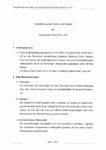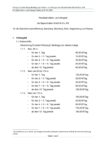- Home
- Frequently Asked Questions
FAQ - Frequently Asked Questions
Die für eine Nutzung des Hafens fälligen Gebühren finden Sie in den verlinkten PDFs.
Dabei sind in den Entgeldbedingungen die geltenden Regelungen hinterlegt.
Konkrete Preise zu Hafengeld, Ufergeld usw finden Sie im Preisblatt.
If you experience disruptions or obstructions during your use of our extensive infrastructure, we can be reached 24/7 at the following emergency telephone number:
Phone: 0800 / 7240 320 (24h)
An architect plans buildings. bayernhafen plans commercial sites – with everything that this involves: land, planning permission, users, synergy between users and successful, modern clusters. bayernhafen develops cross-company and cross-location strategies, invests in high-performance infrastructure and unlocks new added value potential in cooperation with the resident companies.
Environmental factors are increasingly becoming the focus of the logistics sector: “Green logistics” is the catchphrase with which environmentally friendly traffic concepts are being implemented. bayernhafen takes this one step further. We do not regard the issue of sustainability as a job but as a defining factor of our actions.
Our strategic site management involves revitalising existing land and commercial areas. We support renewable energy generation technologies – the roofs of our logistics buildings are equipped with solar panels and our ports are ideal locations for producing bio-diesel production and for biomass-CHP plants. The high international distribution of labour in our globalised world requires environmentally friendly freight transport concepts – an important contribution to this is achieved through the networking of the modes of transport.
These are only some of the examples of how we are protecting our environment. Environmentally conscious and sustainable action is the common thread that runs through everything that our company does. All our locations are focused on the future.
The logistics industry offers a wide range of jobs and careers. It is the people who ensure that the logistics chain is not interrupted, whether in the commercial sector or in the transportation of goods by road, rail or water.
bayernhafen has six locations: Aschaffenburg, Bamberg, Nuremberg, Roth, Regensburg, Passau – located on the Main, Main-Danube Canal and Danube, with direct integration into the international rail and road network.
bayernhafen’s six locations throughput over 9 million tonnes of cargo and freight per year by rail and inland waterway. This includes a range of goods, from bulk and liquid goods through to premium industry products, such as automobiles, construction machinery, containers, fertilisers, iron ore, scrap iron, foodstuffs, generators, cereals, timber and timber products, plastics and coal, agricultural products, machinery, mineral oil, paper, quartz sand, steel, stone, turbines, wind energy converters, and cement.
The companies serve the transport, warehousing, logistics, services and production industries. This includes freight forwarders and shippers, but also animal feed and timber mills, or even a biomass-CHP plant.
The locations are assigned to tenants on a rent and leasehold basis – that is, they are the owners of the property for a specific period of time. We offer flexible and tailored concepts to our customers. Firstly, single source, strategic real estate management guarantees an ideal mix of industries while at the same time ensuring corresponding synergy effects and sustainable use of the port infrastructure. Secondly, we create reliable conditions for the companies operating from our ports and give them the option of adapting the sizes and shapes of the areas they occupy to meet their current needs.


